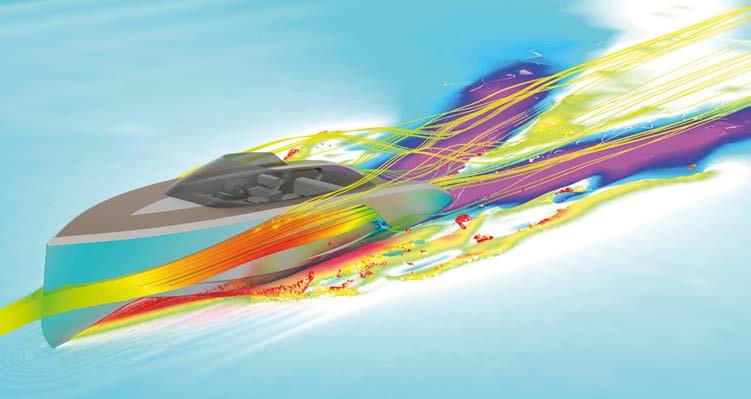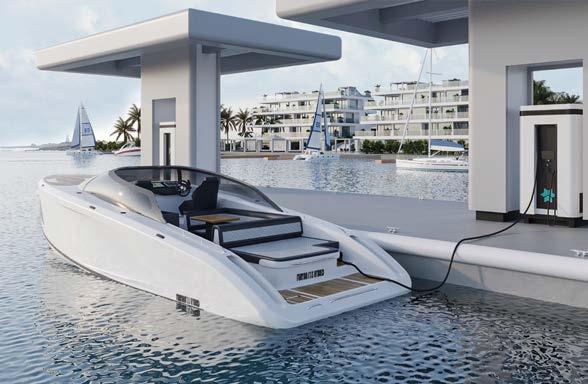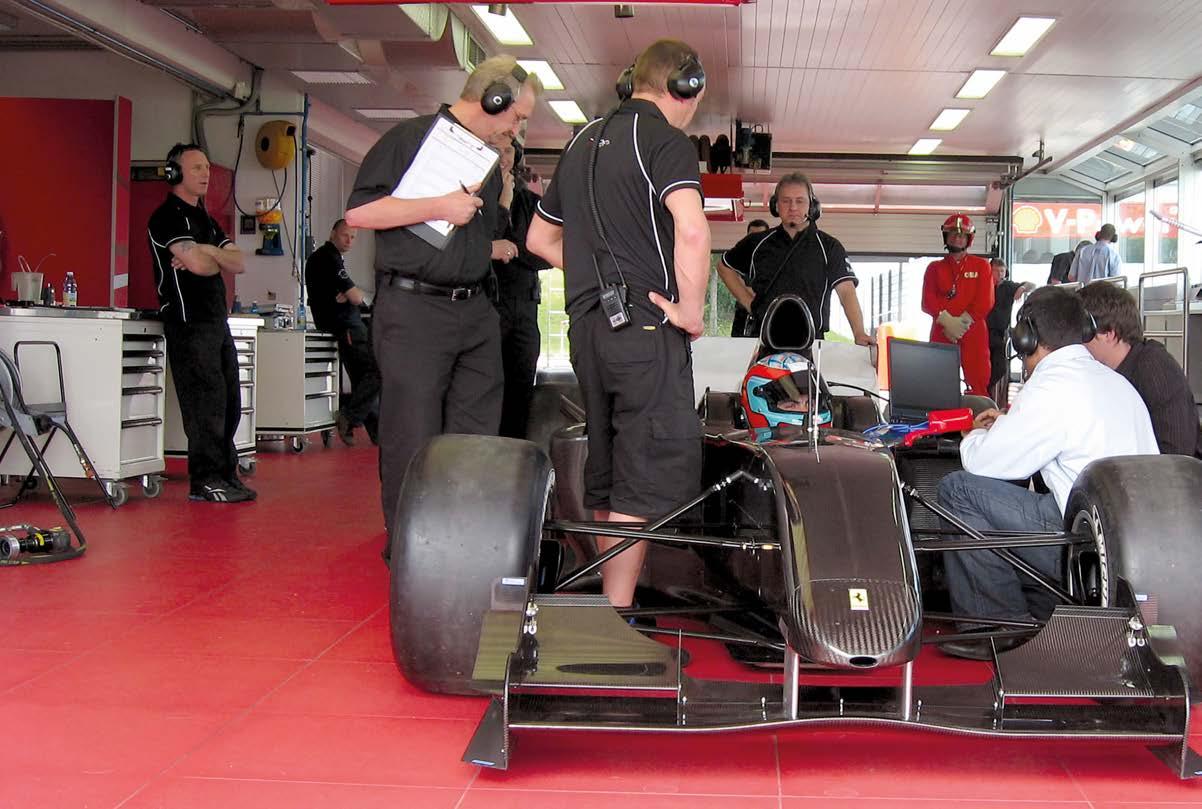
19 minute read
A1 GP
Part of the design brief was that the car have a ‘family resemblance’ to the 2004 Ferrari F1 car. Rory Byrne designed that one, and was tasked with overseeing the A1GP project in a similar capacity. Shown is the finished car at Fiorano for its first test
Full speed ahead
Former technical director and chief designer, John Travis, explains how A1GP’s second generation racecar was conceived, designed and delivered as a full grid in under a year
By JAMES KMIECIAK
Known as the ‘World Cup of Motorsport’, A1GP began in 2005 / ’6 with a racecar based on a Lola B05/52 chassis, powered by a 3.4-litre Zytek V8, and clad in a stylised bodywork and aerodynamics package that led to it being dubbed, not altogether unkindly, ‘the Batmobile’.
It produced ferocious racing and partisan crowds wherever it travelled, which, in turn, attracted future F1, WEC and DTM drivers and engineers to the international one-make series. By the 2007 / ’8 season, it regularly delivered what F1 was lacking at the time – overtaking and spectacle.
After three seasons of events, in which nations rather than teams and drivers competed against each other, and with what later transpired to be somewhat curious finances bubbling beneath the surface, a decision was made to build a brand new car. The reason for this sudden shift was led by an offer from a new engine supplier. Coming off the back of the dominant Schumacher era in F1, and with a recently crowned champion in Raikkonen, nobody hid the fact this was largely a marketing exercise. The caché of Ferrari involvement brought undoubted value to the series and helped to promote Ferrari’s road car division. However, even that brand value wasn’t enough as the category lasted for just one further season (2008 / ’9) before it went into liquidation.
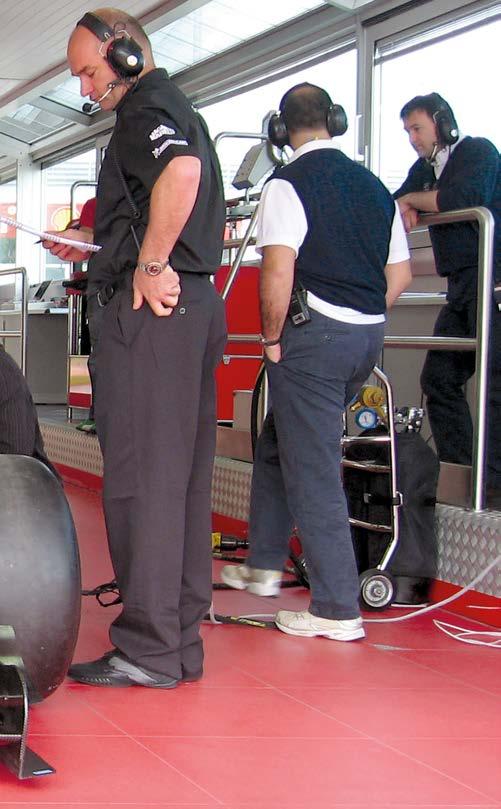
The reasons for the collapse are outside our remit here, but the story of the genesis of the second generation A1GP car is fascinating. It is not simply another archetypal tale of how motorsport engineered a top-quality product in a very short timeframe. It’s the story of how an idea became a grid full of cars to F1 quality of the day in a matter of months, starting from scratch with no factory and no personnel.
Former technical director and chief designer on the project, John Travis, shares his recollections of events with Racecar.
First contact
Travis, previously chief designer at Lola and at Penske Cars, had been working as technical director (special projects) at Epsilon Euskadi since 2004, and it was while testing at Estoril in 2007 that Bruce Homes, the chief
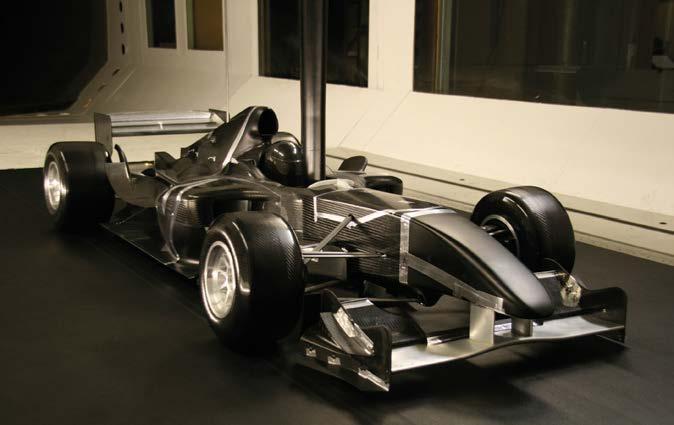
While there were definite cost constraints, a big effort was made to build a good car, with a progressive aero envelope
operating officer of A1GP, came to see him. ‘Bruce invited me to design the new car but, to be honest, I wasn’t keen at first. However, he explained the link with Ferrari was serious, and suggested I went to meet the people at Ferrari to see just how serious they were.’
And so, in October 2007, Travis travelled to Maranello and met with Jean Jacques His, Mario Almondo, Rory Byrne, Mauro Rioli and Marco Galli, names enough to be convincing of the manufacturer’s serious intent.
‘However, they then wanted to come and see our factory.’ It was a reasonable request, except no facility existed at that point.
‘How do you sustain a building when contracts come along as and when?’ asks Travis. ‘But, by the time they visited in midNovember, we had put together a factory for them to visit.’
Travis went to URT Composites in Bognor Regis, southern England, a company he’d already had dealings with, and director, Max Cox, pointed out that the unit adjacent to URT was available, with office space and was ideal for the purpose.
‘It was just an empty shell,’ remembers Travis with what might be a guilty grin, ‘so we had to make it look like a functioning factory. Our PC suppliers loaned us some PCs, we got some office furniture and sat some CAD guys in front of them.
‘Mario Almondo, then Ferrari F1 technical director, and Rory Byrne came over, so we took them to see our UK-based ‘preferred suppliers’, which included Xtrac, and only after that showed them the ‘A1GP Technology factory’. We explained it was all new, and where everything would be.
‘The deal came together very quickly from there and we then had to set up in earnest. The decorators and builders were in over Christmas and we opened on 2 January 2008.’
The overall approach to the design and manufacture of the new car was to create a strong team of preferred suppliers that, in addition to Xtrac, included Pankl, ATL and Penske Dampers, who were all persuaded to join the project. URT ultimately did all the composite work too, as we shall see later.
‘We utilised our key partners’ expertise and people to do R&D, as well as manufacture components,’ explains Travis, ‘while we just had six or seven design people.’
Byrne, who had extended his tenure as F1 designer at Ferrari in a consultative capacity, had been asked to oversee the A1GP ‘Powered by Ferrari’ project in a similar capacity. As Travis notes, that played a big part in its success: ‘Rory and I got on, and this was a strong link in our ability to do this.’
Design brief
As ever, the design specification was based on key aspects and broad principles, the most important of which being, as Travis recalls, ‘the Ferrari brand be protected at all costs, so what they wanted, they got.’ From there, he went on to write a detailed specification with every single item spelled out.
‘The car was only going to run on category two circuits (Portimao, Zandvoort, Brands Hatch, etc) and this determined lap times, power requirements and performance parameters. Importantly, the car had to have a ‘family resemblance’ to the [Byrne-designed] 2004 Ferrari F1 car. Ferrari helped us a lot with that.’
‘But F1 cars are very expensive, and we were a one-make formula with cost constraints, so there were target costs for production, including amortisation of design, moulds and so forth.
‘But we weren’t going to follow the notion of creating a car for the sake of it. We made a conscious decision to make it very good, with a progressive aerodynamic envelope. You have to remember that the teams were only going to see their cars when they arrived at the circuits. There was no opportunity for them to test and develop in between races.
‘Other key areas were a rear diffuser and ground effects, wide track, but not a wide front wing because we knew how to make front wings benign when a car steered. But a really important aspect was weight distribution, due to the heavy engine.’
Because Ferrari only made genuine race engines for its F1 programme, the new A1GP racecar was to be powered by a road car V8 from the manufacturer’s new F430 model. However, at 160kg, it was some 40kg heavier than the previous generation’s Zytek V8.
‘Whatever we did,’ continues Travis, ‘we couldn’t get the weight distribution far enough forwards, so we were going to overload the rear tyres. We were offered the tyre sizes from the World Series by Renault car, which had about 450bhp, but we were targeting over 600bhp. That meant we were not going to be able to balance the car.’
So Travis and colleagues paid a visit to French tyre manufacturer, Michelin, in Clermont Ferrand. ‘We showed them our simulation results, which demonstrated that we would have an oversteering car, and asked them for a bigger rear tyre. With the might of Ferrari beside us, they agreed and made a new bespoke mould for us. This then tied in with buying new rims from OZ.’
Travis is in no doubt that without the Ferrari involvement this special dispensation from Michelin would not have been made on the tyres, and it was a crucial factor in helping to make the car work well.
Lean and mean
‘Recruiting and getting infrastructure in were big issues at the start. My ex-Penske Cars colleague, Paul Baker, and I spent Christmas 2007 – working around the builders and decorators – wiring in PCs ahead of the contract designers coming in on 2 January. Thankfully, we got a good group of people in, who got stuck in and worked closely and well together.
‘Remember, we had no car design history, no archive of parts and no schedule. Peter Morgan, who was with me at Epsilon Euskadi, did the scheduling with a huge Gantt chart on his wall. Alan ‘Hatchett’ Harris was the buyer. We had to put him in a soundproofed room as he took no nonsense from any suppliers. Martin Dixon was production manager. Stuart Allen was in charge of composites with Paul Baker, and Mario Saccone worked in Bognor and Italy on finite element analysis. We were a very mean, lean team.
‘We also had a very good inspection department, and a very good inspector / storeman, who set up a system so all stores were bar coded and everything was made in batches to keep unit costs down. The bar coding meant we knew exactly what parts we had, and each car comprised over 2500 parts. To think that one man did all that is incredible. We practically built the inspection room around the inspector during the early stages.’
Returning to the point made earlier about utilising the skills and resources of their preferred suppliers, Pankl designed, analysed, manufactured and tested all of the suspension, including the uprights (made using electrical discharge machining, EDM) and wishbones.
Xtrac did the same with the gearbox. Travis’ team designed its cast magnesium casing, Xtrac then doing the finite element analysis before manufacturing it.
‘It was an unusual gearbox because of the high crankshaft height,’ remembers Travis. ‘Ferrari didn’t want to do a specialist sump for the engine, which meant we had to have a big shear plate under the engine. This meant the crank was high, 125mm above the bottom of the shear plate, so the gearbox ran input drop gears to step the gear cluster down to lower the c of g of the transmission. The drop gears also stepped down the torque, which allowed slimmer, lighter change gears, too.’
It was a longitudinal, six-speed transmission (based on Xtrac’s successful F1 arrangement in use since 1995) and the ratios were changed from the front end.
‘The sump only had scavenge ports on the right-hand side, meaning we’d lose oil pressure in long right-hand corners as the oil was not returned to the oil tank and was retained in the engine. So we had to re-design the oil tank baffling to reduce this issue. As we hadn’t got a car at that point, we were testing an oil tank lying on its side in the workshop so we could simulate the g forces!’
When a chassis was complete, and the engine installed, track testing of the baffled oil tank was undertaken at Snetterton as the team found the long linking right handers of The Bomb Hole and Coram perfect test beds for similar tracks on the proposed calendar.
In keeping with F1, carbon brakes were employed for stopping duties. ‘Brembo made bespoke calipers and discs for us,’ continues Travis. ‘We wanted long life material so, through Michael Messina, they provided endurance specification material.’
Unsurprisingly, given the Ferrari connection, Magnetti Marelli was the preferred partner for the electronics, and Anton Stipinovich the man who designed the systems for the A1GP car.
‘The electronics were bloody complicated, and included the Bosch direct injection fuel

The engine was a 600bhp, roadgoing V8 from Ferrari’s F430 model. Its 160kg weight caused some problems with balance
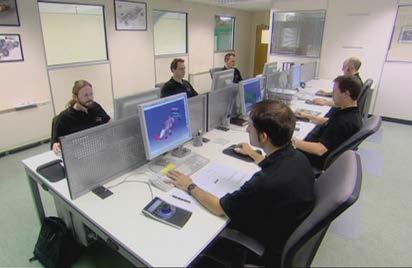
The design office team. This was pretty much the size of the operation

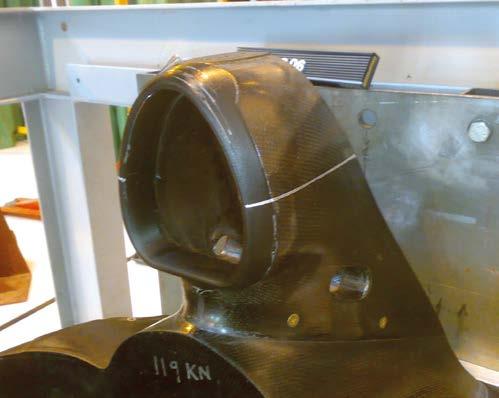
FEA was used to develop the car’s FIA-standard, Formula 1-spec composite roll hoop, which was made from a billet aluminium mandrel clad with a carbon fibre exterior
system, gearbox control, anti-stall and so forth. Every car had live telemetry on it, and Ferrari had screens of data on every car, each of which had GPS. Ferrari did not want to see an engine blow up in public, so there were two technicians per car. It was an entourage.’
Keeping cool
‘All of that was led by Michelotto, who tuned the engine. They put us under extreme pressure to get everything right, especially with regard to cooling. We were in Maranello every two weeks for technical reviews. I remember they gave us heat rejection figures from the dyno, and there was a total of 190kW from the oil and water systems, and I was just thinking, ‘how are we going to cool this?
‘The friction in a production engine is a lot higher than a normal race engine. So the oil cooler was a heat exchanger in the v of the engine, and from wind tunnel work and pressure coefficients from the radiators we calculated we needed 3470cm2 of cooler area. Once we had that knowledge, Docking Engineering made bespoke coolers for the car.
‘Ferrari also had a specific warm-up procedure we had to follow, involving starting, warm up, seal the system, pressurise it with a small hand pump, and off you go. Even the coolant we used was controlled [by Ferrari].’
Having discussed the chassis requirements with many well-known composite manufacturers, it was decided to bring everything as close to ‘in-house’ as possible, by using the next-door neighbour, and experienced motorsport chassis manufacturer, URT Composites.
‘All our composites parts were made by them. We had a close relationship in all respects and it just made sense to use them and be in control, and perhaps achieve some cost savings, too. But it was all very high-quality stuff, including a composite roll hoop to pass the FIA’s standard F1 tests. It was unheard of to make a composite roll hoop for a one-make series, but we developed a process using a Rohacell ‘spider’ with a carbon exterior and an aluminium billet internal mandrel, for which we had calculated the thermal expansion to consolidate the moulding. That enabled us to develop a production process.
‘Even the [40 per cent scale] wind tunnel model was bloody good, despite being for a one-make series. All the aero development was done with this in the ex-Penske tunnel at Southampton University, there was no CFD.
Production process
‘But because of the overall timescale we had, there was absolutely no development time, which meant we had to do a lot more FE analysis to help get things right first time.
‘Despite that, we did have a catastrophic side impact test failure at TRL [Transport Research Laboratory, Wokingham, UK] and we had already committed to production on the basis of a good prototype… Fortunately, it wasn’t actually down to the side impact structure itself, it was because the restraints had allowed the tub to move and tip so the load was off axis and the impact structures were not applied head on. They consequently folded and collapsed.
‘So we cut that chassis in half and glued the good half for a re-test. And then we retested another chassis in a machined buck that prevented any movement and it was okay. We also then sleeved the side impact tubes in top hats bonded to the chassis.
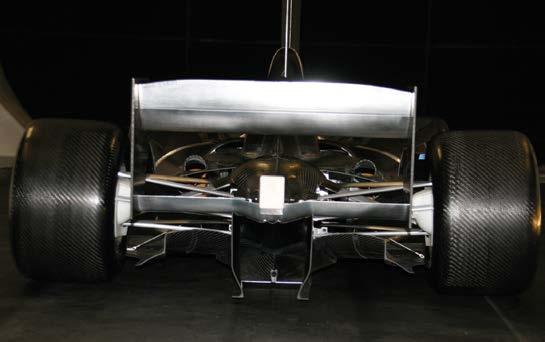
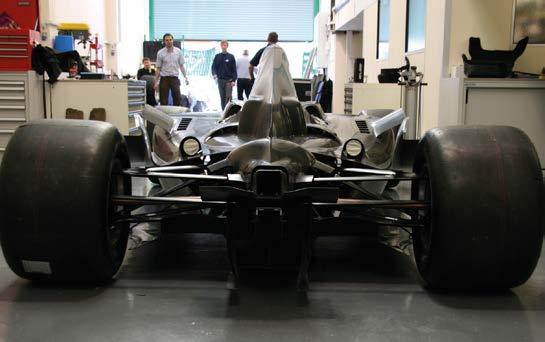
‘We also made a fundamental error on the ergonomics and had to make a 50mm longer chassis and impact test it, which meant making one extra chassis for one team [and two spares].’
Pre-production testing
By May 2008, the first car was completed and shipped to Ferrari’s own test track at Fiorano where it began a relentless testing schedule across Europe via Imola, Jerez, Mugello, Paul Ricard and Magny Cours, before it was joined three months later by the first production car at a cold and wet Silverstone in autumn.
With just two months to go before the season started, the test car had completed over 5000km with very few issues. Those that did raise their head were reported back to the design team, a solution identified, prototype parts made and shipped out before being signed off for application to the ‘production’ cars, after having proved themselves at the next test session.
But even with such an intense preproduction testing schedule, problems were still being identified during the season, as parallel testing was undertaken. One such issue related to the fuel system after the cars tested at Kyalami in South Africa, as Travis recalls: ‘Due to the heat and altitude, the fuel was boiling in the tank and vaporised by the time it reached the injectors. This caused huge misfires. We had to develop a suitable low-pressure scavenge pump set up and pressurised accumulator system, which meant heating a full fuel tank to 60degC in the middle of the factory floor to simulate the problem before developing a solution, manufacturing a grid full of kits and shipping them out to be fitted weeks before the race.’
Which leads us on to the question, how did a relatively small group of engineers build 25 cars in such a short period of time, while at the same time ensuring the individual teams had long enough to learn how they went together prior to the first race?
Slot cars
Travis explains: ‘The teams were all invited to book their build slot and send over their own team of mechanics. We would then have three to four cars being built at the same time under the supervision of our three primary mechanics.’
This also led to Travis asking himself how he would best like to approach the race engineering of a one-make series.
‘So we built a full vehicle dynamics programme for the teams to do their own simulations. We got it ready for the first race, with Karl Niklas giving lectures to all the teams on how to use it. We gave the teams everything, so they didn’t need to develop their own programmes.’
As for transport between races. ‘There were two 747s with the whole grid in. They were full of ‘shack packs’, moved by Delivered on Time [DoT], the freight company. Ultimately, they were the biggest creditors, and the cars were sold to a South African buyer [AFRIX Motorsport] in 2015 to settle that debt.’
With mention of the series’ demise put aside, the collaboration, ingenuity and organisation shown by Travis and his team ensured the 17 teams that contested the first race at Zandvoort on 5 October 2008 were able to get up to speed quickly, compete on a level footing and set lap times over three seconds faster than had been achieved in the previous generation of A1GP car. And do all of that in front of packed grandstands.
‘The timeframe for a hi-tech car, despite being one-make, was a credit to everyone involved. I don’t know how we managed it all, but everything just seemed to drop into place,’ Travis says while reflecting on the enormity of the project, before concluding, ‘It was an honour. We were the only people to build a Ferrari-badged car outside Maranello. It was definitely one of the best projects to have worked on.’

The test car was subjected to a brutal three-month testing schedule at tracks across Europe, including Imola (shown)

With no time for track testing, the team had to get creative in the factory. Here the fuel tank is being pressure tested
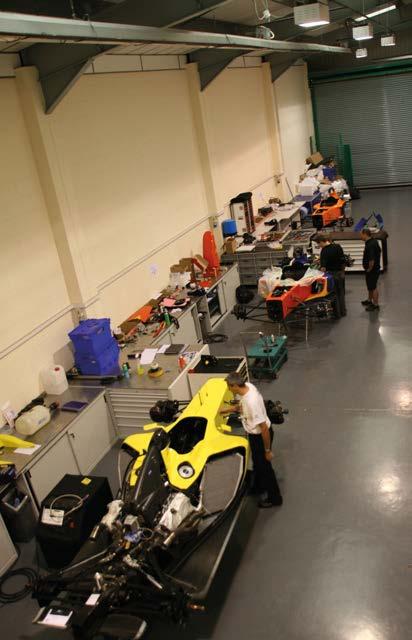
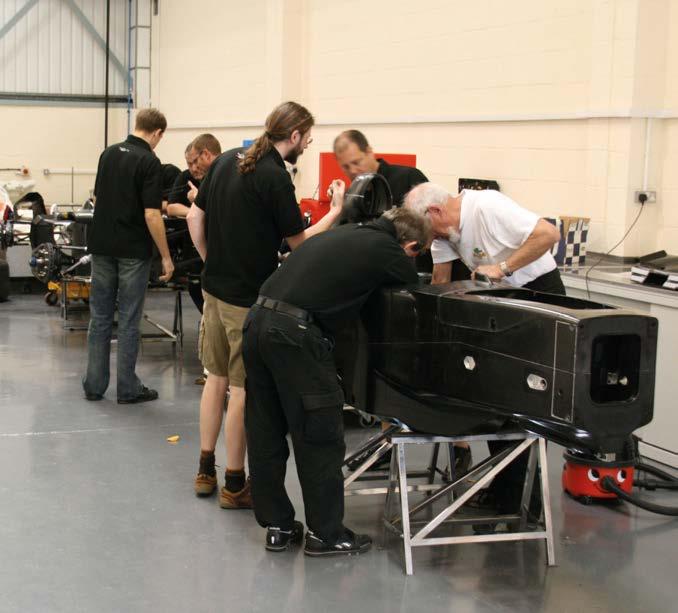
Cars were built three at a time, and teams invited to book a slot and send over their own mechanics to be involved
Furyan’s innovative flax fibre hull has been developed in CFD to optimise efficiency in the speed range it is designed for
Clearly, range is a big issue with electric boats, and so Furyan’s motor control unit is linked to its Navionics system to ensure a journey is achievable
What happened next?
For John Travis, it was a sideways step as he now puts all the lessons learned from his years in motorsport into his new passion, electric motorboats.
With the majority of current EV technology focussed on the automotive sector, he noticed nobody was designing and manufacturing systems to help reduce C02 emissions of leisure boats.
‘A lot of people were just dropping automotive systems into boats that were not designed for this type of duty cycle. Our system uses a cascade motor system, rotary engine range extender and an optimised energy management system to ensure maximum range and efficiency.’
The Furyan F35 also utilises a monohull built from flax fibre, as being trialled in motorsport to reduce manufacturing emissions by 75 per cent over GFRP and 90 per cent over CFRP. With input from CFD expert, TotalSim, the hull has been designed to improve efficiency at the range of speeds associated with this style of cruiser.
Taking the racing links a step further, the motor control system is linked to the onboard Navionics (sat nav) to ensure when a route is plotted the motors can be optimised to guarantee the target journey range is achievable, much like planning pit stop strategy in an endurance race.
For more information, visit www.furyanmarinetechnology.com
